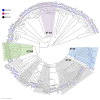Emergence and Genomic Features of a mcr-1 Escherichia coli from Duck in Hungary
- PMID: 37887221
- PMCID: PMC10604428
- DOI: 10.3390/antibiotics12101519
Emergence and Genomic Features of a mcr-1 Escherichia coli from Duck in Hungary
Abstract
Plasmids carrying high-risk resistance mechanisms in pathogenic E. coli have gained particular attention in veterinary medicine, especially since the discovery of the colistin resistance gene, mcr-1. Here, we provide the first evidence of its emergence and describe the complete mcr-1 plasmid sequence of a multi-resistant avian pathogenic E. coli (APEC) strain from waterfowl in Hungary. Whole-genome sequencing analysis and core-genome MLST were performed to characterize the genome structure of the mcr-1 plasmid and to reveal the phylogenetic relation between the Hungarian duck strain Ec45-2020 and the internationally circulating mcr-1-positive E. coli strains from poultry and humans. Results showed that plasmid pEc45-2020-33kb displayed a high level of genome identity with mcr-1 plasmids of IncX4 type widespread among human, animal and food reservoirs of enteric bacteria of public health. The mcr-1-positive E. coli strain Ec45-2020 belongs to the ST162 genotype, considered as one of the globally disseminated zoonotic genotypes of MDR E. coli. In accordance with international findings, our results underline the importance of continuous surveillance of enteric bacteria with high-risk antimicrobial resistance genotypes, including neglected animals, such as waterfowls, as possible reservoirs for the colistin resistance gene mcr-1.
Keywords: colistin resistance; core genome MLST; mcr-1 Escherichia coli; multiresistance; plasmid genome; waterfowl; whole-genome sequencing.
Conflict of interest statement
The authors declare no conflict of interest.
Figures




References
-
- Jørgensen S.L., Stegger M., Kudirkiene E., Lilje B., Poulsen L.L., Ronco T., Pires Dos Santos T., Kiil K., Bisgaard M., Pedersen K., et al. Diversity and population overlap between avian and human Escherichia coli belonging to sequence type 95. mSphere. 2019;4:e00333-18. doi: 10.1128/mSphere.00333-18. - DOI - PMC - PubMed
-
- Apostolakos I., Laconi A., Mughini-Gras L., Yapicier Ö.Ş., Piccirillo A. Occurrence of colibacillosis in broilers and its relationship with avian pathogenic Escherichia coli (APEC) population structure and molecular characteristics. Front. Vet. Sci. 2021;8:737720. doi: 10.3389/fvets.2021.737720. - DOI - PMC - PubMed
LinkOut - more resources
Full Text Sources

